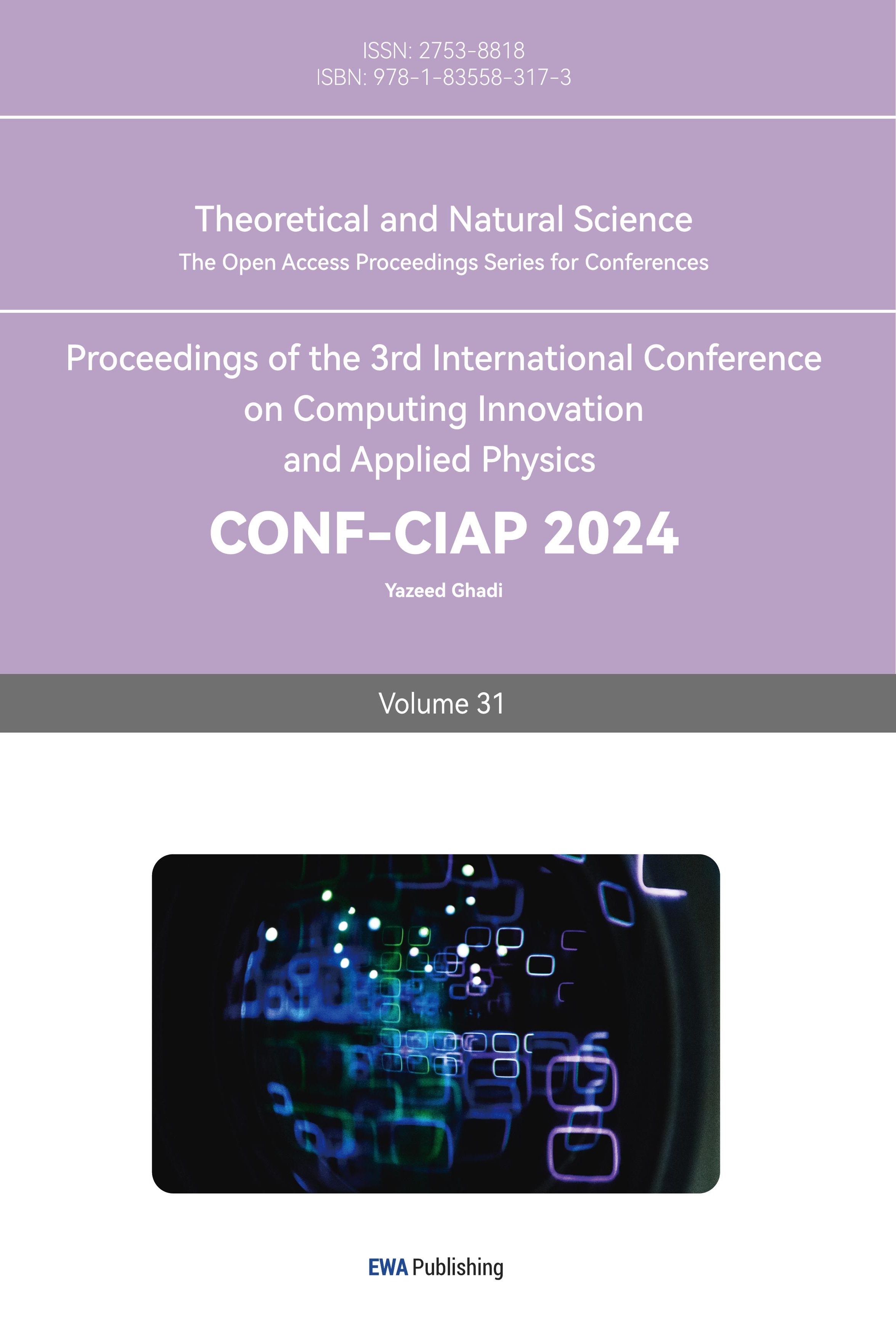1. Introduction
As we know in the past outstanding studies, Kepler-453 is an eclipsing binary stars system found in 2015 in Lyra, 1448.5534 light years from solar system. The host star Kepler-453A is a G7 type star, 0.934 \( { M_{⊙}} \) and 0.833 \( { R_{⊙}} \) with the surface temperature is 5527K, while the companion star Kepler-453B is an old red dwarf with only 0.194 \( { M_{⊙}} \) ,0.214 \( { R_{⊙}} \) and 3309K. The orbit is 0.185 AU with eccentricity 0.0524, and the period of the binary rotation is 27.32 days which caused the evident eclipsing in light curves as a sharp and short decline of the optical flux.
The circumbinary planet (CBP) of this system, Kepler-453b, found by transiting in light curves, is a giant planet with 16 \( {M_{⊕}} \) and 6.2 \( {R_{⊕}} \) with 0.25 \( {G_{⊕}} \) , orbiting the G star 240.5 days as a single period. For detecting Trojan for the circumbinary planet. Transit timing variation (TTVS) measurement is a very effective observation method for detecting planets [1,2]. Its amplitudes of TTVs can indicate three essential parameters: the mass ratio of the transiting planet to the perturbing planet (like a Trojan planet), the transiting planet’s cycle, and the disturbed planet’s eccentricity. The efficient advantage for TTVs to detect Trojan with the transiting celestial body that TTVs are greatly improved when two planets come close to the mean motion resonance (MMRs) [1,3].
The orbit is 0.79 AU in the conservative habitable zone determined by complex analysis method (see in part 2), which needs difference parameters of the radiation received in various distance or the orbit of the current planet to calculate whether anther earth-sized planet can stably stay in the habitable zone [4]. Although the result shows that none of the similar sized planet can stay stable in the habitable zone mainly due to the gravity of the current giant planet. They also simulate the number of planetesimals and embryos and show how many stars are grown from dust particles and planets during the planet’s initial absorption, so they can form a new body through the inelastic collisions between embryos and planetesimals with constant mass and momentum. This paper will further review and analyses their method in part 2 and the region of different habitable zone of Kepler 453.
In addition, some studies did the research about the stability of Trojan planets or moons in this system as a positive candidate for life, since they can form a stable co-orbit with the current planet in habitable zone and the ejection and collision are rare in Lagrangian points where they can strongly couple each other as a equilateral triangle [5]. Previous studies have shown that the low eccentricity of binary stars and their planets is conducive to the formation of cooperative orbit structures [6].
So, in this paper, this paper will look back such research for the light curves of this binary and the extra possibility for the other planet that can stay in the habitable zone as a meaningful example to do further research of such type of binary system for the habitable exoplanet. Also, the radiation and plasma environment of the Kepler-453 system [7] will be mentioned as a background support for understanding the dynamical habitable zone but it will be not served as the center of discussion.
2. Methods used in light curves and past research
2.1. The light curves of Kepler 453
The light curves I do analysis with is based on the python using the extended package Lightkurves, searching for the database ranging from the Kepler,K2 and TESS space telescopes with observing data in different quarters, mainly employed in building the light curves of stars to detect the transit signal of exoplanet and also help to estimate a star’s mass and radius using asteroseismology.I did some light curves with different types of signal of Kepler 453 for its main eclipsing, secondary eclipsing and transit of planet. They have shown the distinct features to distinguish.
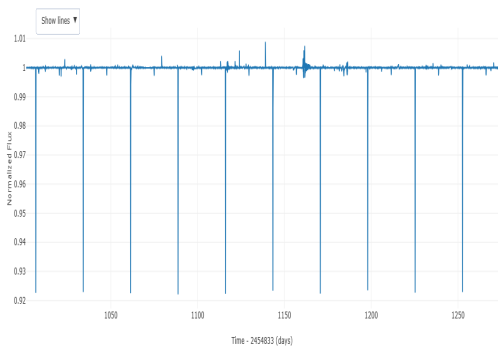

Figure 1. The binary period through the main eclipsing and secondary eclipsing: the sharp, short and regular decline in light curve and a relatively smooth, long-lasting decrease when the companion star is in front of the host star
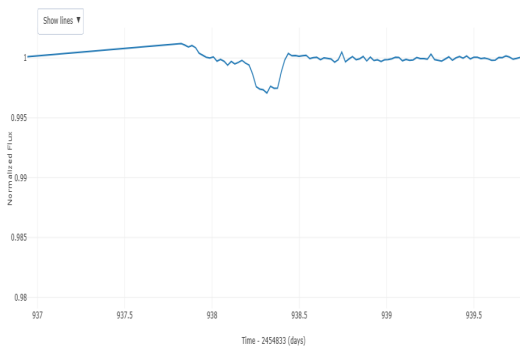

Figure 2. A transit signal in the light curves: more optical depth than secondary eclipsing and last longer. The right graphs come from previous paper done by Welsh & Jerome & Donald in 2015 [8].
As a result, the same data can be concluded from the Lightkurves that the period of main eclipsing is 27.32 days, optical depth is 8%. The last time of secondary eclipsing is 0.2 days, optical depth is 0.25% while the period of transiting is 240 days, lasting 0.5 days with optical depth is 0.045%.
2.2. The methods used in finding Trojan and earth-sized planet
As mentioned in part 1, this review will put the emphasis in other possibility of the extra exoplanet in Kepler-453.They build different but mainly similar model for the definition and simulation for the habitable zone, based on the radiation environment from the binary and the gravity of both celestial bodies.
2.2.1. Radiation and plasma environment. According to Jorge et al., the purpose is to limit the radiation and plasma environment in the habitable region and to study its possible effect on the evolution of the simulated hypothetical terrestrial planets and moons’ atmosphere [7].
The HZ limit of the system is calculated by determining the radius of the circle centered on the center of mass of the system, where the mean flux of the binary is equal to the critical flux, and then the evolution process of the system is derived from this limit. The detailed calculation can be saw in the reference paper.
There are three indexes to evaluate its overall habitability: the insolation received from the binary, X-ray, and extreme ultraviolet (EUV), the current intensity of charged particles (mainly protons), and the corresponding magnetic field. The direct interaction between continuous particle flow-magnetic fields and the atmosphere has essential effects on nonmagnetic planets and satellites including the existence of the atmospheres, the received radiation, and the formation of liquid water.
2.2.2. Trojan planets. The most important concept in finding Trojan is about the MMRs and the Lagrangian points. The previous work of Laughlin& Chambers, Cresswell& Nelson, and other scholars found that only on a few occasions Lagrangian points (especially L4, L5) can produce celestial bodies with a 50-60% mass ratio ( \( {M_{⊕}} \) ) [9,10]. Lyra et al. extending this simulation to a smaller model, it is assumed that a disk formed by the high-speed impact of self-gravitational gas particles and solid particles between stacked solid particles; a star of 2.6 \( {M_{⊕}} \) can be formed at the Lagrange point of the giant planet.
According to the simulation carried out by Jeffrey et al. [5], because the distance between Troy and its host star is very close, photometry has been a very effective method to detect the distance between binary stars, and they use TTVs to observe. Through physical and orbital parameters, detailed integration was performed using the Bulirsch-Stoer integrator in a version of the N-body divider MERCURY. They put 10,000 objects as the candidates of Trojan, distributing in L4 and L5 with roughly equal quantity with random initial orbit elements. The initial semi-major axes, eccentricities and inclinations are randomly generated with Gaussian distribution in certain regions. In other CBP, there was no statistical difference in the number of Trojan horses between L4 (leading) and L5 (trailing).
2.2.3. Earth-sized planet in various defined habitable zones. The so-called “habitable zone (HZ)” refers to the existence of space suitable for living organisms in terrestrial planets, that is, stars containing gases such as CO2, H2O, and N2 with a large amount of water on their surface [11,12].
In the binary star system, scientists use two different modes to study the narrowband and broadband bands in order to find out their respective HZ [1,13].
Table 1. The two models of the narrow and wide HZ for Kepler453
systems | Haghighipour & Kaltenegger | Mason et al. | ||||||
Kepler453 | Narrow HZ | Wide Hz | Narrow HZ | Wide Hz | ||||
Inner AU | Outer AU | Inner AU | Outer AU | Inner AU | Outer AU | Inner AU | Outer AU | |
0.70 | 1.25 | 0.55 | 1.31 | 0.75 | 1.33 | 0.59 | 1.41 | |
The details of the simulation were completed by the Minor Mercury package with the N-body Mercury Numerical Integrator with the binary system hybrid integrator option (Chambers 1999), which mainly tested the numerical evolution of particles (non-gravitational interactions), binary systems, and current planets [14,15]. And the detailed parameters of Kepler453 is available in Table 2.
The particles are randomly distributed along the HZ, with an additional 20% margin of the total HZ width on each side, and the eccentricity is zero to establish the initial function of the particle distribution. Each \( {au^{2}} \) has a particle density of 160. When the semi-major axis of the particle exceeds 10 AU, it is removed from the simulation and the final integration time is 1 Myr. The results of simulation were divided to two conditions owing to the different index of the destiny of the planets solid surface of \( Σ{1r ^{-x}} \) ,where \( x = 1.5 \) and \( 2.5 \) at 1 AU.
Table 2. The parameters from William et al 2015 [8]
Keplcr-453 System Parameters | |||
parameters | best fits | uncertainty | units |
binary | |||
M1 | 0.944 | ±0.010 | \( { M_{⊙}} \) |
M2 | 0.1951 | ±0.0020 | \( { M_{⊙}} \) |
R1 | 0.833 | ±0.011 | \( { R_{⊙}} \) |
R2 | 0.2150 | ±0.0014 | \( { R_{⊙}} \) |
Orbital period | 27.322037 | ±0.000017 | days |
Tconj | -34.574012 | ±0.000060 | BJD |
inclination | 90.266 | ±0.052 | degrees |
e sinw | -0.052 | ±0.0037 | / |
e cosw | -0.006339 | ±0.000016 | / |
eccentricity | 0.0524 | ±0.0037 | / |
arg periastron | 263.05 | ±0.48 | degrees |
semimajor axis | 0.18539 | ±0.00066 | AU |
limb darkening q1i | 0.41 | ±0.06 | / |
primary q2i | 0.07 | ±0.11 | / |
secondary q12 | 0.33 | ±0.11 | / |
secondary q22 | 0.07 | ±0.07 | / |
T1 | 5527 | ±100 | K |
T2 | 3226 | ±100 | K |
log g1 | 4.571 | ±0.015 | egs |
log g2 | ±5.0630 | ±0.0050 | egs |
planet | |||
Mp | 0.2 | ±16.0 | \( {M_{⊕}} \) |
Rp | 6.204 | ±0.039 | \( {R_{⊕}} \) |
Orbital period | 240.503 | ±0.053 | days |
Tconj | 69.020 | ±0.054 | BJD |
inclination | 89.4429 | ±0.0091 | degrees |
e sinw | -0.00322 | ±0.00023 | / |
e cosw | -0.03575 | ±0.0088 | / |
eccentricity | 0.0359 | ±0.0088 | / |
arg periastron | 185.1 | ±3.7 | degrees |
semimajor axis | 0.7903 | ±0.0028 | AU |
nobal longitube | 2.103 | ±0.055 | degrees |
mutual inclnation | 2.258 | ±0.039 | degrees |
3. Results and discussion of these work for Kepler453
3.1. The radiation and plasma environment
In the simulation done by Jorge et al 2016, the condition of Kepler453 is similar to our solar system [7]. As discussed in Part 1, the sun, XUV, and magnetic flux are the three key factors determined by the primary star, and the short period and low eccentricity of the binary cause the star to have minimal tidal interactions. Because the intensity of extreme ultraviolet radiation is small and the intensity of star wind is small, the planets near the BHZ region are habitable.
Theoretically, the environment can harbor more like the Venus-like planets even in the edge of the habitable zones, compared the XUV and magnetic fields fluxes with Venus. The details can be seen in Resources above
3.2. The distribution of Trojan in habitable zones
Simulations based on the n-volume splitter, assuming an MMR of 1:1 to obtain a better time scale comparable to the lifetime of the star, have shown the final dynamic state of each Troy in Figure 5 corresponding to its initial semi-major axis (a), eccentricity (e) and orbital inclination (i). However, it is difficult to maintain due to the gravity of the host planet [5]. Except for 3 ejected, black symbols for the collision with 6618 and red symbols for the stable existence with 3379.The result of the stable ones mainly gather in the \( e \lt 0.2 \) and the \( i \lt 15° \) .
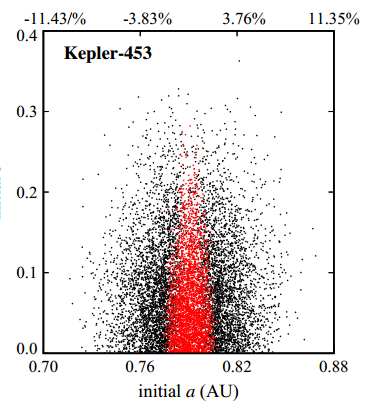
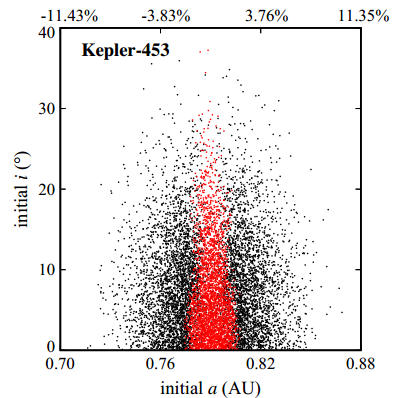
Figure 3. The dynamical states of the Trojan planets with respect to their initial Semi-major axes and initial orbital eccentricities/initial orbital inclinations.
However, the effective region of stable distribution is too narrow to consider the practical condition without the restriction of simulation. They also deduce some interesting results. The eccentricity will increase with bigger amplitude of TTVs due to the perturbation of the host circumbinary planet. It also happens with longer period to detect clearly when the mass of host planet is smaller. But it still can be expected in the future observation because the detection of Trojan can frequently fall in the range of the timing precision of the Kepler telescope.
3.3. The formation and stable position of earth-like planets
Through numerical simulations observing the evolution of the embryos and planetesimals done by Barbosa et al, the mass within 0.6 to 0.9 of earth were formed, but none of them were in the HZ considering the two conditions of \( x=1.5 \) and \( x=2.5 \) [14]. It is mainly because the current giant planet, Kepler453b, have been already in the habitable zone which gravity caused plenty of ejection and collision of the objects to expel the earth-sized planet beyond the HZ. When \( x \) is 1.5, the average mass thrown becomes smaller. In this case, the weight of the disk was reduced by 10% to 0.5 Myr, while in the same period of time, 16% of the mass was lost to \( x \) is 2.5.
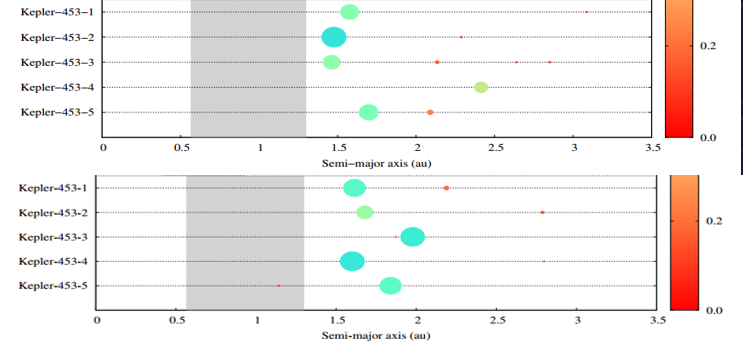
Figure 4. The above one is the \( x=1.5 \) situation and the below is \( x=2.5 \) .Shaded gray is the HZ. The green objects are between 0.6 and 0.9 \( {M_{⊕}} \) [13]
4. Conclusion
The divisions of the HZ are similar in this previous work and the simulation could be done by N-body generator like MERCURY. In fact, Nikolaos et al define more types of the HZs with different region like permanent HZ, extended HZ, average HZ with the formulas based on the parameters including spectra weight, orbit semi-major axis, eccentricity and so on. You can search for them in the reference list if you are interested in.
For Kepler 453 system, the conservative HZ is relatively narrow compared with other Kepler binaries. The possibility for other planet is restricted also due to the existence of the current giant planet which may not habitable for its lack of the solid surface can ejected the smaller planets or collapse with them. But fortunately, the stability of Trojan planets that composed an equilateral triangle with a star and host planet in
Lagrange points (L4 and L5) has been confirmed by many researchers, although in this system, the limits of the region for semi-major axes, the initial eccentricities and inclinations are strict and the frequency of the formation of a Trojan is still rare. It could be expected to detected the planets or large moons in HZ and be served as a meaningful example to detect other Kepler terrestrial planets.
References
[1]. Haghighipour N. & Kirste, S. 2011, CeMDA, 111, 267
[2]. Giuppone, C. A., Benítez-Llambay, P. & Beaugé, C. 2012, MNRAS, 421, 356
[3]. Veras, D., Ford, E. B., Payne, M. J. 2011, ApJ, 727, 74
[4]. Circumbinary habitable zones in the presence of a giant planet,Nikolaos Georgakarakos
[5]. On the Detection of Habitable Trojan Planets in the Kepler Circumbinary Systems,Jeffrey J. Sudol and Nader Haghighipour
[6]. Demidova, T. V. & Shevchenko, I. I. 2018, AstL., 44, 119,Demidova, T. V. 2018, SoSyR, 52, 180
[7]. [CONSTRAINING THE RADIATION AND PLASMA ENVIRONMENT OF THE KEPLER CIRCUMBINARY HABITABLE-ZONE PLANETS,Jorge I. Zuluaga
[8]. Welsh, W. F., “Kepler 453 b - The 10th Kepler Transiting Circumbinary Planet, The Astrophysical Journal, vol. 809, no. 1, 2015. doi:10.1088/0004-637X/809/1/26.
[9]. Laughlin, G. & Chambers, J. E. 2002, AJ, 124, 592
[10]. Cresswell, P. & Nelson, R. P. 2006, A&A, 450, 833
[11]. Selsis F., Kasting J., Levrard B., Paillet J., Ribas I., Delfosse X., 2007, Astronomy & Astrophysics, 476, 1373
[12]. Kaltenegger L., Sasselov D., 2011, The Astrophysical Journal Letters, 736, L25
[13]. Haghighipour N., Kaltenegger L., 2013, The Astrophysical Journal, 777, 166 Mason P. A., Zuluaga J. I., Cuartas-Restrepo P. A., Clark J. M., 2015, International Journal of Astrobiology, 14, 391
[14]. Earth-size planet formation in the habitable zone of circumbinary stars,G. O. Barbosa
[15]. Amarante A., Winter O. C., Sfair R., 2019, Journal of Geophysical Research: Planets, submitted
[16]. Chambers J. E., 1999, Monthly Notices of the Royal Astronomical Society, 304, 793
Cite this article
Zhang,W. (2024). A review for Kepler-453 binary system and its giant planet. Theoretical and Natural Science,31,346-352.
Data availability
The datasets used and/or analyzed during the current study will be available from the authors upon reasonable request.
Disclaimer/Publisher's Note
The statements, opinions and data contained in all publications are solely those of the individual author(s) and contributor(s) and not of EWA Publishing and/or the editor(s). EWA Publishing and/or the editor(s) disclaim responsibility for any injury to people or property resulting from any ideas, methods, instructions or products referred to in the content.
About volume
Volume title: Proceedings of the 3rd International Conference on Computing Innovation and Applied Physics
© 2024 by the author(s). Licensee EWA Publishing, Oxford, UK. This article is an open access article distributed under the terms and
conditions of the Creative Commons Attribution (CC BY) license. Authors who
publish this series agree to the following terms:
1. Authors retain copyright and grant the series right of first publication with the work simultaneously licensed under a Creative Commons
Attribution License that allows others to share the work with an acknowledgment of the work's authorship and initial publication in this
series.
2. Authors are able to enter into separate, additional contractual arrangements for the non-exclusive distribution of the series's published
version of the work (e.g., post it to an institutional repository or publish it in a book), with an acknowledgment of its initial
publication in this series.
3. Authors are permitted and encouraged to post their work online (e.g., in institutional repositories or on their website) prior to and
during the submission process, as it can lead to productive exchanges, as well as earlier and greater citation of published work (See
Open access policy for details).
References
[1]. Haghighipour N. & Kirste, S. 2011, CeMDA, 111, 267
[2]. Giuppone, C. A., Benítez-Llambay, P. & Beaugé, C. 2012, MNRAS, 421, 356
[3]. Veras, D., Ford, E. B., Payne, M. J. 2011, ApJ, 727, 74
[4]. Circumbinary habitable zones in the presence of a giant planet,Nikolaos Georgakarakos
[5]. On the Detection of Habitable Trojan Planets in the Kepler Circumbinary Systems,Jeffrey J. Sudol and Nader Haghighipour
[6]. Demidova, T. V. & Shevchenko, I. I. 2018, AstL., 44, 119,Demidova, T. V. 2018, SoSyR, 52, 180
[7]. [CONSTRAINING THE RADIATION AND PLASMA ENVIRONMENT OF THE KEPLER CIRCUMBINARY HABITABLE-ZONE PLANETS,Jorge I. Zuluaga
[8]. Welsh, W. F., “Kepler 453 b - The 10th Kepler Transiting Circumbinary Planet, The Astrophysical Journal, vol. 809, no. 1, 2015. doi:10.1088/0004-637X/809/1/26.
[9]. Laughlin, G. & Chambers, J. E. 2002, AJ, 124, 592
[10]. Cresswell, P. & Nelson, R. P. 2006, A&A, 450, 833
[11]. Selsis F., Kasting J., Levrard B., Paillet J., Ribas I., Delfosse X., 2007, Astronomy & Astrophysics, 476, 1373
[12]. Kaltenegger L., Sasselov D., 2011, The Astrophysical Journal Letters, 736, L25
[13]. Haghighipour N., Kaltenegger L., 2013, The Astrophysical Journal, 777, 166 Mason P. A., Zuluaga J. I., Cuartas-Restrepo P. A., Clark J. M., 2015, International Journal of Astrobiology, 14, 391
[14]. Earth-size planet formation in the habitable zone of circumbinary stars,G. O. Barbosa
[15]. Amarante A., Winter O. C., Sfair R., 2019, Journal of Geophysical Research: Planets, submitted
[16]. Chambers J. E., 1999, Monthly Notices of the Royal Astronomical Society, 304, 793





